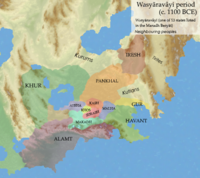Saria
State of Saria دولت از نمابر Kešvar-e Fâxtaran Kœšvar-e Pœxtəran | |
|---|---|
| Capital and | Shavand |
| Official languages | Pouremanian |
| Recognised regional languages | List of languages
|
| Ethnic groups | |
| Religion | State religion:
Constitutionally recognized minorities:
|
| Government | Unitary one-party socialist Navdaric republic |
• Dastur | Shadmehr Modiri |
| Hamidreza Mashayekhi | |
| Payam Vossoughi | |
| Parsa Rastegar | |
| Sina Zamani | |
| Sirvan Kamran | |
| Legislature | National Congress |
| Constitutional Court | |
| People's Political Consultative Conference | |
| Population | |
• 2019 census | 114,506,546 |
| GDP (PPP) | 2019 estimate |
• Total | $1.962 trillion |
• Per capita | $17,141 |
| GDP (nominal) | 2019 estimate |
• Total | $688 billion |
• Per capita | $6,016 |
| Gini (2019) | 39.5 medium |
| HDI (2019) | 0.799 high |
Saria (Pouremanian: نمابر Fâxtaran; Pactrian: نمابر Pœxtəran), officially the State of Saria (Pouremanian: دولت از نمابر Kešvar-e Fâxtaran; Pactrian: دولت از نمابر Kœšvar-e Pœxtəran),
Etymology
History
Classical antiquity

By the second millennium BC, the Asuro-Majulan peoples had arrived in what is now Poumeran and largely displaced the native population. By the first millenium BC the native settlers had largely been assimilated or driven out. According to Poumeranian tradition, it was around 1800 BCE that the semi-legendary Khwarrah Empire emerged in Central Poumeran. According to the later Sagas of Selagus, written around 500 BCE, the Khwarrah consolidated the Eight Tribes under one banner and firmly established a Poumeran identity.
By the 14th century BCE any centralised authority potentially exerted by the Khwarrah had vanished, beginning the Wasyaravayi period. Poumeran was divided between twenty-four states, and by the 12th century BCE this had been reduced to thirteen. Each state in theory owed allegiance to the Khwarrah king reigning in Khos, but in reality they no longer fully obeyed the Khwarrah king and continually waged war with each other in the 400-year Wasyaravayi period. Though a period of intense and devastating warfare, it also saw great cultural and religious changes and awakenings, with both Nawdhar and Osmaryn coming from this era.
The Wasyaravayi period ended in 662 BCE with the conquest of the other states by the state of Gur. The Duke of Gur maintained the institution of the Khwarrah kings until the death of Artawahishta IV, when they left the throne empty and instituted themselves as regents. Garshasp, the third regent and Duke of Gur, enacted great reforms throughout Poumeran, notably the forced standardization of the Poumeran alphabet, measurements, road widths (i.e., cart axles' length), and currency. He also instituted strict anti-Navadarist and anti-Osmarynist policies, favouring the Darayat faith. This period, known as the Gur Usurpation, would end in 591 BCE with the conquest of Poumeran by Kutian tribes, instituting a short period of Kutian rule before a civil war fractured the Khwarrah empire into various polities.
Following this widespread civil war, the Varastatids, a Arashian dynasty consolidated power in eastern Poumeran, and by 565 controlled all of Poumeran proper. Under Osroes I they would




